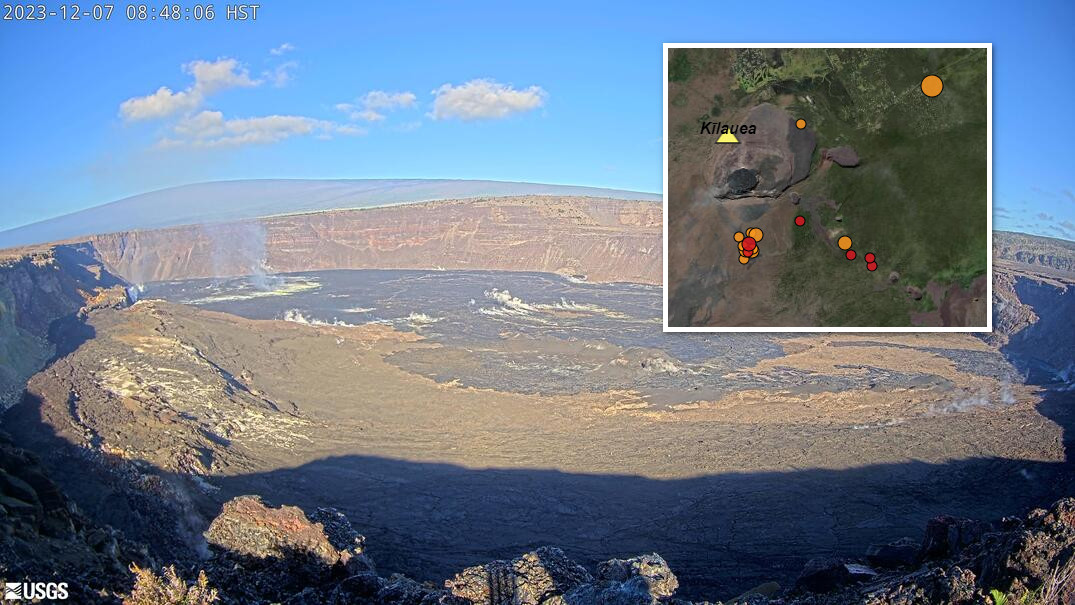(BIVN) – Kīlauea is not erupting, and moderate seismicity has returned to the summit region, as unrest at the volcano is apparently on another waxing trend.
The USGS Hawaiian Volcano Observatory reported a slight uptick in earthquakes that began last night, focused in the area south of Kīlauea’s summit caldera, ending several days of relatively low seismicity. The activity “did not reach the levels seen during an earthquake swarm on December 2, nor the levels that immediately preceded recent summit eruptions,” scientists noted.
There was also continued, low-level seismic activity in the upper East Rift Zone and Southwest Rift Zone over the past day.
Two recent notable earthquakes – yesterday’s magnitude-4.4 earthquake east-northeast of the summit, and today’s magnitude-3.6 deep Pāhala earthquake – were not directly related to near-surface volcanic activity, scientists believe, “and no associated changes were observed at Kīlauea”.
No unusual activity has been noted along the middle and lower East Rift Zones.
Scientists continue to say that volcanic unrest “may continue to wax and wane with fluctuating input of magma to the area, and eruptive activity could occur in the near future with little or no warning.” The USGS Alert Level remains at ADVISORY.
From the USGS Hawaiian Volcano Observatory on Thursday, December 7th:
Summit Observations: Summit seismicity experienced a slight uptick last night, focused in the area south of Kīlauea’s summit caldera. This followed several days of relatively low seismicity, but activity did not reach the levels seen during an earthquake swarm on December 2, nor the levels that immediately preceded recent summit eruptions. A M4.4 earthquake occurred east-northeast of the summit at 5:17 p.m. HST yesterday at a depth of 14 mi (23 km), and a M3.6 earthquake occurred east-northeast of Pāhala at 7:13 a.m. HST today at a depth of 21 mi (33 km); neither of these earthquakes are believed to be directly related to near-surface volcanic activity, and no associated changes were observed at Kīlauea.
The Uēkahuna summit tiltmeter—located northwest of the caldera—tracked steady inflationary tilt until around midnight last night, when there was a quick transition to deflationary tilt. Despite a brief interruption between 5:00 a.m. and 7:00 a.m. HST this morning, the deflationary trend continues at this time. The Sand Hill tiltmeter—located southwest of the caldera—has tracked similar trends. Overall, the summit of Kīlauea remains at a high level of inflation; relative tilt is above the level reached prior to the most recent eruption in September 2023, and it is higher than at any time since the 2018 eruption.
Sulfur dioxide (SO2) gas emission rates remain low. Field measurements indicated an SO2 emission rate of approximately 70 tonnes per day on December 5, which was similar to measurements in October and November.
There are currently no signs of an imminent eruption, but the summit region remains unsettled, with a high level of inflation and moderate seismic activity. The onsets of previous summit eruptions have been marked by strong swarms of earthquakes caused by the emplacement of a dike 1–2 hours before the appearance of lava, and these swarms are not being detected at this time.
As of Thursday morning, there were no additional closures in Hawaiʻi Volcanoes National Park due to the volcanic unrest, aside from the continued closure of the Mauna Iki Trail and the Kaʻū Desert Trail (south of the Footprints exhibit to the Mauna Iki Trail intersection) in the Southwest Rift Zone.


by Big Island Video News9:38 am
on at
STORY SUMMARY
HAWAIʻI VOLCANOES NATIONAL PARK - Scientists say moderate seismicity returned to the Kīlauea summit region last night with a slight uptick in earthquakes.